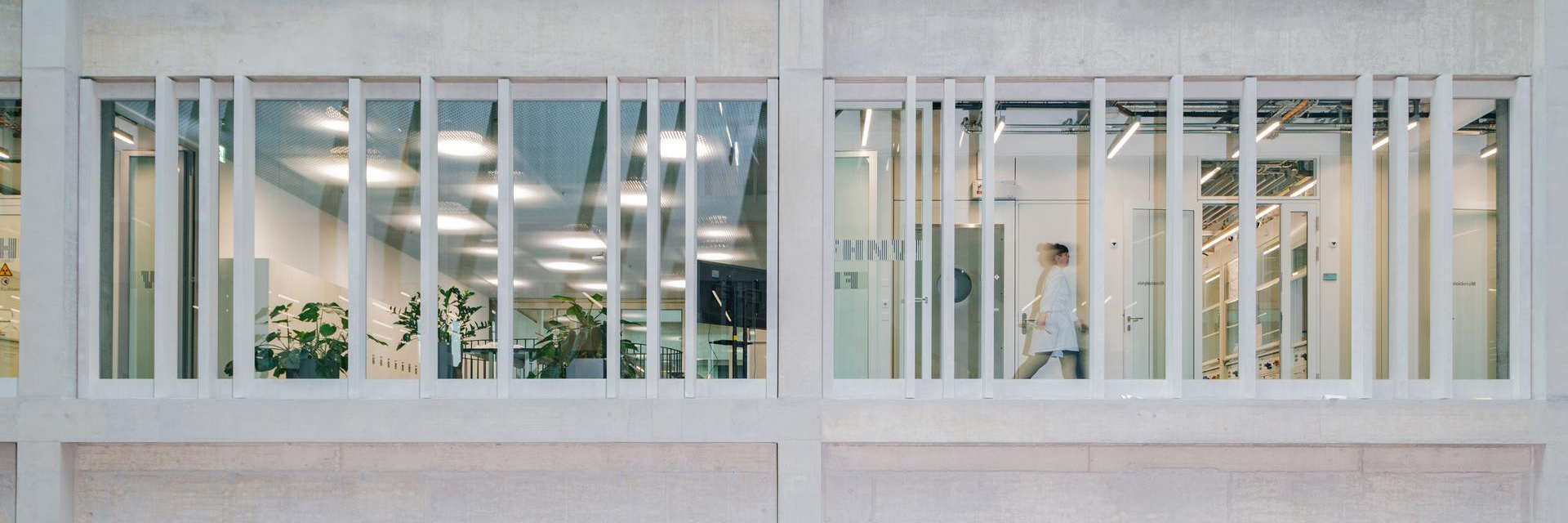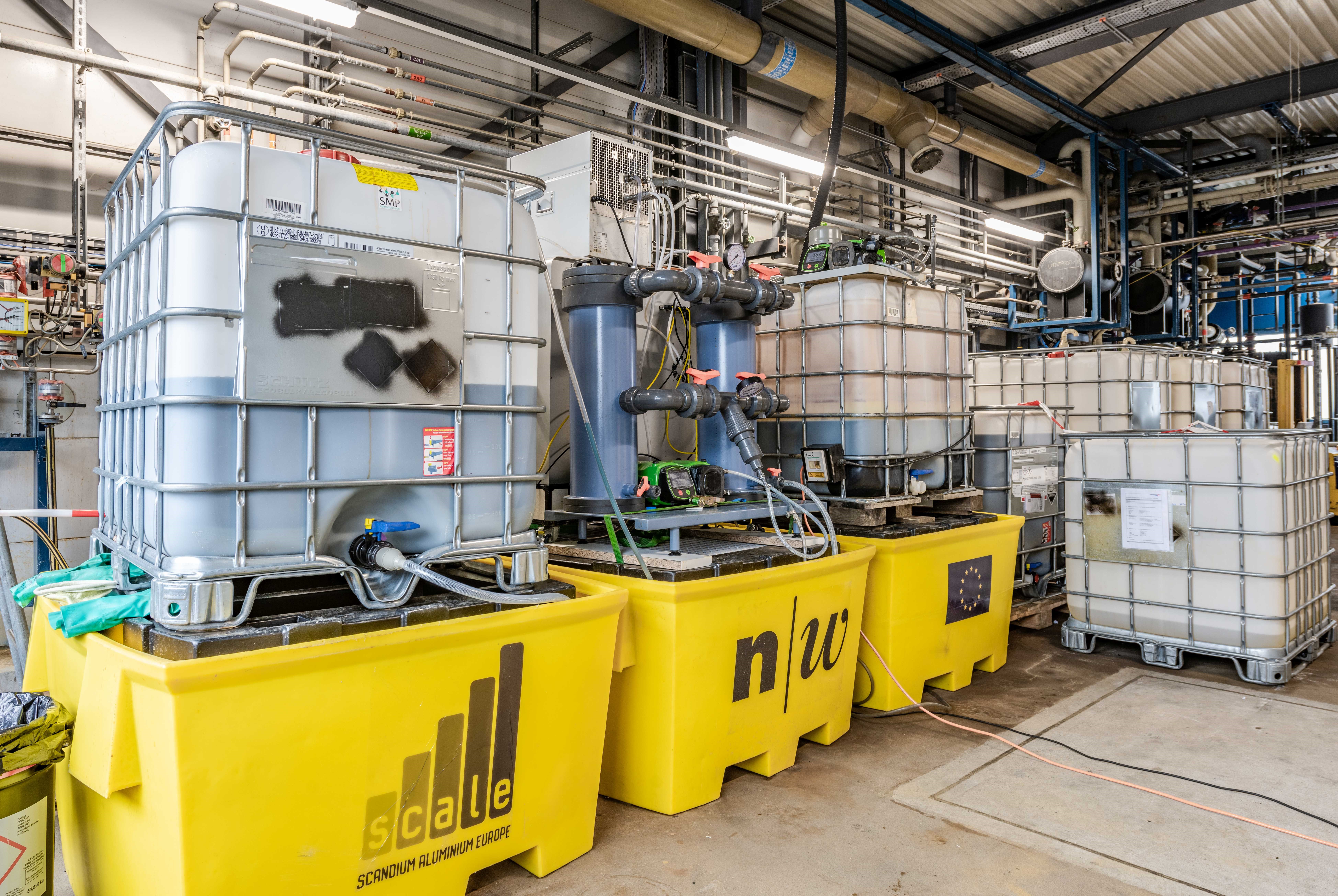Treasures in production waste
Researchers at the School of Life Sciences FHNW (HLS) have developed a process for recovering the rare earth metal scandium from acidic industrial wastewater by means of filtration. The promising laboratory method was tested for its industrial suitability in a pilot trial at the GETEC PARK.SWISS AG.
The element scandium is one of the critical raw materials and yet it ends up on landfill sites - for example in form of industrial waste from white pigment and aluminium production. The EU-funded pan-European research cooperation SCALE aims to recover the valuable scandium from industrial waste and establish new European supply chains. The University of Applied Sciences and Arts Northwestern Switzerland School of Life Sciences is involved in the project together with its partner GETEC PARK.SWISS AG. In a pilot test in the industrial halls of the chemical park, HLS chemist Sebastian Hedwig is testing whether scandium can be extracted from strongly acidic process waste water by means of filtration. The promising laboratory tests at HLS are thus intended to prove their practical suitability on a larger scale and advance the technological maturity. This is because there is a need for action on the rare earth metal scandium throughout Europe.
«Waste is processed in a useful way and we give the aviation and high-tech industry in Europe a certain independence»
For more sustainable aircraft and fuel cells
Scandium is important to many industries, especially the aerospace industry, where it improves the strength and weldability of aluminium alloys, enabling the construction of lighter and more fuel efficient aircrafts. Through its use in solid oxide fuel cells, it is also important for alternative power generation. «So you have an element with great potential, but not an adequate supply,» says environmental biotechnologist Markus Lenz of HLS. The researcher and his team are involved in the EU project SCALE, which is funded by Horizon 2020. SCALE stands for «Production of Scandium compounds and scandium aluminium alloys from European metallurgical by-products».
Europe does not have yet exploitable natural scandium deposits, but many millions of tonnes of waste from aluminium production and the manufacture of the white pigment titanium dioxide. «These wastes also contain valuable scandium in small quantities», explains Lenz. «If European countries tap into these secondary scandium sources, we will have a double profit. Waste is processed in a useful way and we give the aviation and high-tech industry in Europe a certain independence». In the SCALE project, HLS researchers have developed an important sub-process that creates the raw material for further scandium production. This will then be taken over by project partners in other European countries.
A successful cooperation
«For our tests we received process waste water from the white pigment production in the Netherlands. We have to remove interfering substances from this waste water and then concentrate the liquid so that it contains a particularly large amount of scandium,» explains Hedwig. At his test site in the GETEC PARK.SWISS chemical park, there are numerous cubic metre plastic tanks. The brown acidic wastewater broth in one of the tanks appears not very friendly to the environment: it is corrosive and contains a whole cocktail of metals. For GETEC PARK.SWISS the handling of such substances is part of everyday business. With its infrastructure, high safety and environmental standards and the know-how of its employees, the chemical park is an important development partner that bridges the gap between laboratory and industry. HLS's scandium research is also in line with GETEC PARK.SWISS AG's «Waste to Value» corporate philosophy, i.e. recognising waste as a possible resource: You eliminate it and gain something.
Several filtration steps retain scandium
Sebastian Hedwig has designed his experimental plant in such a way that a clear, scandium-rich liquid is produced from the acidic wastewater broth. He achieves this with a multi-stage filtration system. First, the acidic process wastewater is pre-treated, followed by microfiltration using special filter bags. These filter bags filter out particles larger than one micrometre. Subsequently, those particles smaller than one micrometre are removed by ultrafiltration. The last and most important stage is nanofiltration. «The special thing about nanofiltration is that it does not screen out particles but charged particles,» explains Hedwig. «We know that scandium in a solution is always triple positively charged. However, a nanofiltration membrane only allows single-charged ions to pass through, so scandium is retained.» The larger and more strongly charged a molecule is, the less passes through the membrane and is lost. With the multi-stage filtration process, the researchers were able to reduce the volume of the original process wastewater by 60-70 percent under laboratory conditions and obtained a concentrate with more than twice as much scandium as at the beginning of the filtration.
The design of the test plant and the selection of suitable materials were decisive for the success of the project. «Since we work with a pressure of 35 bar, we could not use plastic parts,» explains HLS chemist Hedwig. «These would not withstand the pressure. In addition, the materials must be acid-resistant over a long period of time and must not corrode». The pilot test provides important data to identify possible bottlenecks in the process that would not be visible on a laboratory scale. For example, it has already been shown that microfiltration works less well in the pilot test and the filters have to be changed more often. Nevertheless, the first wastewater was successfully treated on a cubic meter scale. This concentrate is now being refined into a pure scandium product by other project partners. Thanks to the close cooperation of European teams of experts, scandium is thus being produced for the first time in tangible quantities from European waste.
This project has received funding from the European Union’s Horizon 2020 research and innovation programme under grant agreement No 730105 (SCALE: www.scale-project.eu/). This work was supported by the Swiss State Secretariat for Education, Research and Innovation (SERI) under contract number 16.0155. The opinions expressed and arguments employed herein do not necessarily reflect the official views of the Swiss government.

